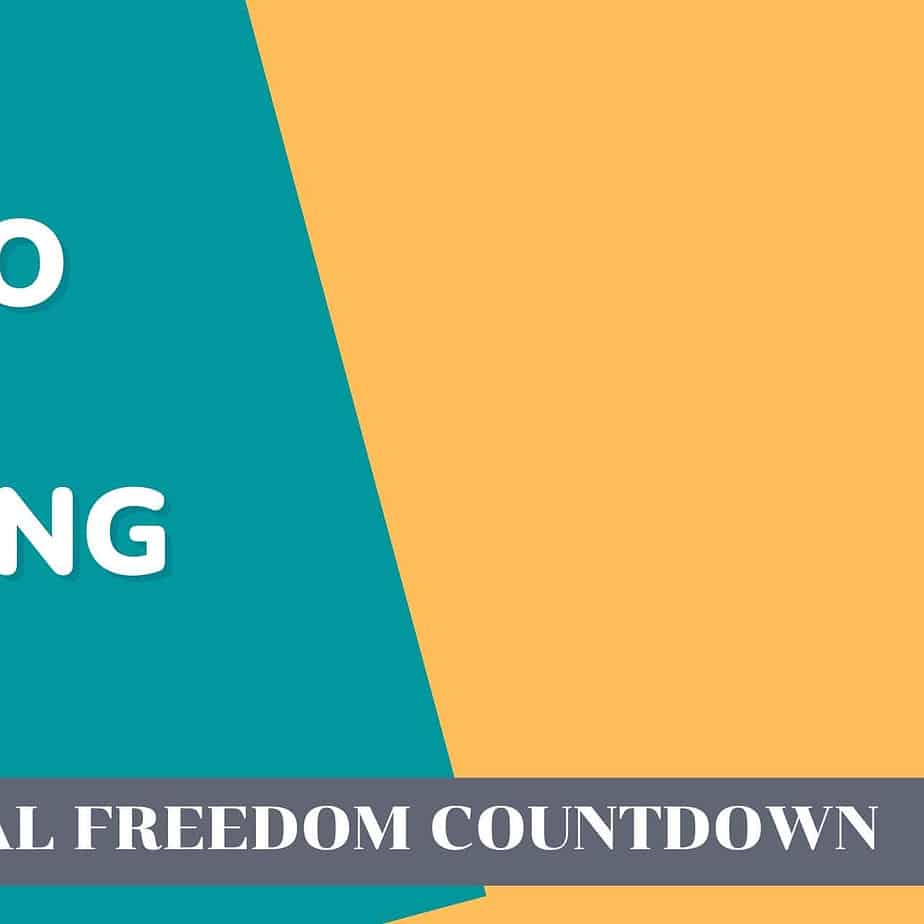How To Stop Spending Money: 5 Tips To Curb Your Overspending

When it comes to taking control of our personal finances, at its core, there are two things we can do.
The first is to find ways to increase the money we bring in. That can involve using our high-income skills at our day job, saving more, learning how to invest, or getting an additional income stream through side hustles. These actions are often difficult to execute or require a high upfront investment of time or money. Or they take a long time to show results while we hemorrhage money.
What is more manageable is to figure out how to stop spending money. Spending money is necessary for life, as we all need to purchase goods and services to keep us safe, healthy, and happy. However, learning how to stop spending money – or at least spend less on things that don’t improve our happiness – can be a critical key to success in our financial lives.
Despite the difficulties with controlling your spending, there are many ways that you can learn how to stop spending money. Here is an overview of some of the best hints and things you can do to spend less, save more, and have a healthier financial future.
5 Tips To Stop Spending Money
Examine Your Spending
The crux of learning how to stop spending money is first to identify where you are spending money. You can only do this with the right organizational tools, as you won’t be able to tell where you spend money.
So, from a practical perspective, what does this mean? You have to know how you spend money. Sit down and review your various bank, credit card, and debit card statements. All this information is available online, and you can likely export the data into an excel spreadsheet.
Tracking how you spend cash can be more difficult since there are often no receipts for cash purchases. However, you must develop a system to monitor your cash spending, even if you note manually how much you spend and where you spend it.
Alternatively, free software like Personal Capital can examine your spending plan and categorize the information. Compared to other apps, Personal Capital doesn’t need you to do the tedious task of manually entering all the information. After you link all your accounts together, it automatically combines all the transactions from every bank account, credit card, and financial institution so you can analyze how your money comes in and where you spend. You can read my Personal Capital Review and how I use the various components to set up your free account.
Creating a record or spreadsheet enables you to examine your spending habits more deeply. Once done, you can create a system that regularly monitors your credit and bank accounts, adding new transactions and seeing where you spend your money.
Once you know where you are spending your money, you can identify ways to quit spending and boost your checking account balance.
Make a Personal Budget
The only way to learn how to stop spending money is to develop a personal monthly budget that can give you a good grasp of where and how you spend your money. You can do this once you thoroughly examine your overall spending habits and patterns.
Building a personal budget means getting a good grasp of every bank account, savings account, and credit card you have. You can use automated software to categorize your spending and create income expectations and spending limits.
You can update your budget every few days – or even every day – to ensure that you are not spending too much money on specific budget categories.
There are several budget templates, including the popular 50/30/20 budget.
Alternatively, you can use free software like Personal Capital to monitor your net worth and stick to a budget. Compared to other budgeting apps, Personal Capital doesn’t need you to do the tedious task of setting up a budget. After you link all your accounts together, it looks at your current spending and creates a budget for your lifestyle. You can then modify it as needed. Personal Capital also has features to analyze your retirement accounts, eliminate fees, and track your liquid net worth and cash flow.
Furthermore, you can create automated spending triggers. This means you can receive a text, notification, or email that lets you know when you are spending too much in a specific budget category.
A budget contains many parts. In addition to your monthly income, it can also list your fixed expenses and discretionary spending. All of this can automate your spending habits and make it easy for you to track your money and develop the self-discipline necessary to reduce the amount of money you spend in various areas.
Budgets can also help you better fulfill specific financial goals. For example, if you find money left in a particular category, you can move that over to another category. This working budget can help you better manage your personal finance and ensure that you pay the least amount possible for your various expenses.
Finally, creating a personal budget can help you save money because it can allow you to create a tangible savings goal you must fulfill every month. Your savings goal is one of the most important aspects of any personal budget. You can adjust all other purchases – including streaming services, eating out, or other entertainment options.
It allows you to adjust your monthly expenses around your savings goals – not the other way around. Doing so can reduce financial stress and help ensure that you have created a personal finance plan that is on track to meet your long-term goals. It can also ensure you spend your money wiser and reduce unnecessary impulse shopping.
Define Your “Why”
The purpose of defining why you want to stop spending money is twofold
1) Having a clear picture of why you are trying to break bad habits will make it easier to stop an impulse buy when the going gets tough
2) The goal will encourage you to stay on track.
Set a Savings Goal
If you genuinely want to save money, you must have a savings goal. After all, it is only possible to save money if you know how much you want to keep!
A savings goal should be realistic. You always want to save more money, so you have to identify the amount you want to save every month, thus allowing you to achieve short, medium, and long-term goals.
As such, create a budget that puts aside more money every month. It can be a raw dollar or a percentage of your overall monthly income. From there, you’ll need to develop the discipline to keep your spending in check and not make impulse purchases at the drop of a hat.
One of the biggest challenges with meeting a spending goal is determining how to complete it. There are a few tips:
- Make this goal a weekly occurrence rather than a monthly one. Putting away money once a week reduces the temptation to waste money, minimizing the chances of making an impulse purchase and not falling prey to temptation.
- Create a budget that allows for purchasing the bare necessities and savings goals. Everything else is a bonus, and this can enable you to stop overspending.
- Double-check your progress regularly and ensure you are making steady progress towards meeting whatever savings goal you set.
Identify Ways To Save Money
First, you should take comfort in that you are not the only person – by a long shot – who has struggled with saving money. It is a massive personal challenge.
The good news is that there are many things you can do when it comes to saving money, eliminating harmful habits, and finding ways to keep more of your hard-earned cash in your pocket.
Some of the strategies include:
Develop Better Habits
Creating a shopping list – rather than just buying what you see on the shelves – can help you create a spending plan that limits what you may otherwise grab as an impulse purchase. More importantly, it can help keep you disciplined and develop healthier long-term spending habits when shopping for groceries or at a big box store.
Remember, learning how to control your spending and stick to your financial goals is a lot like working out. It takes time, practice and patience to get it right.
Alternatives to Traditional Grocery Shopping
For example, many consumers use meal plan services that allow them to have groceries shipped directly to them. This can make it easy for you to cook meals and avoid eating out.
Limit Social Media Exposure
This might sound confusing – what does social media have to do with spending? Social media can make you jealous of how others spend their time and money. It can encourage lifestyle creep and make you want to pay the money you don’t have.
The truth is that social media can increase impulse buying and make you more likely to purchase unnecessary things. Millionaires who are genuinely wealthy practice stealth wealth instead of flaunting their riches.
Reduce Credit Card Usage
Remember, you get hit with sizable interest payments if you don’t pay your credit card immediately, which is wasted money. You can save more money by spending with cash or a debit card, which requires immediate, up-front payment. Look at reducing the amount of money you put on your credit card.
Consider Alternative Ways To Purchase
While everyone wants to shop in their local community, the truth is that you can often shop online and save money on various high-quality purchases, especially for a big purchase.
However, you must be cautious about the instant gratification online purchases bring. It can be far, far too easy to make a significant purchase without putting adequate thought and planning into whatever you buy.
Above all else, ensure you develop the self-discipline not to buy immediately everything you want. Furthermore, conduct extensive research about pricing and quality before you make any online purchase.
Shop Around
There is almost always a cheaper grocery store or way to buy clothes. Regularly examine your bills and see if there aren’t any ways you can reduce those expenses.
Examine All Your Subscriptions
Most companies drain our money by asking us to sign up for subscription services. We often pay for several subscription services and don’t even use them. Trim is an excellent service that looks at all your current subscriptions and saves money by eliminating unnecessary money leeches. Also, instead of paying full price, sign up and see if Trim can negotiate lower cable, phone, and internet bills.
Long-Term Improvements To Stop Spending Money
The only way to stop spending money is to ultimately address the systemic challenges that you have in your personal finances. Yes, you can stop spending money by reducing your spending, but that may not be enough. As such, you must dig deep into your finances and find ways to spend less.
How can you do this?
- First, you need to prioritize your money. Saving for retirement, creating a healthy emergency fund, and having the right insurance products are far more important than eating out, buying new clothes, or paying for the latest streaming service. These are the basics of personal finance, and you need to care for them before you do everything else.
- Almost everyone has some form of debt. You must ensure you correctly pay and prioritize your debt payments to reduce interest payments. Furthermore, paying off your debt and making every on-time payment can improve your credit score. An excellent credit score can increase your ability to get a loan later in life.
- Money paid in interest payments to banks or credit card companies is the very definition of wasteful spending, and while it is a fact of life, you should do whatever you can to keep these payments at a minimum. As such, you need to ensure that you are paying the lowest interest payments possible. To get a lower interest rate, examine alternative solutions, like refinancing debt.
- Despite your best efforts, you may be unable to resist spending money in certain situations. If all else fails, consider getting rid of credit cards or not carrying them. It may make you less likely to take out a card and spend it when you see something you like. At the very least, it can create a physical barrier – and thus a physical reminder – that you are trying to limit your spending. This can be critical to developing healthy spending habits, saving money, and building a solid credit report.
- Avoid social media feeds that portray a lavish lifestyle. Understand the difference between wealthy vs. rich and realize most billionaires practice stealth wealth unless they want to lead a public life. Social media influencers exist to sell you an image and, subsequently, their branded products. Movie and sports stars are rich already. Do you need to buy their branded sneakers or perfumes?
There is no question about it: Learning how to stop spending money can be challenging. For many, spending money is about more than just purchasing necessities, managing a monthly income, or using credit cards.
It can sometimes represent a deep-seated psychological need to spend to make one feel better. Unfortunately, the psychological connections that many have with spending money often make it even more difficult to control spending.
Fortunately, all hope isn’t lost. There are plenty of ways that you can learn how to stop spending money, put more money in your bank balance, and ultimately reduce your money expenses. Proper tracking, developing good habits, and controlling how you use your credit cards can make all the difference in the world.
Once you stop spending money, you will have extra cash in your budget, which you can use for saving or investing. Learn how to invest in stocks. Or real estate investing, which can help you build generational wealth.

John Dealbreuin came from a third world country to the US with only $1,000 not knowing anyone; guided by an immigrant dream. In 12 years, he achieved his retirement number.
He started Financial Freedom Countdown to help everyone think differently about their financial challenges and live their best lives. John resides in the San Francisco Bay Area enjoying nature trails and weight training.
Here are his recommended tools
M1 Finance: John compared M1 Finance against Vanguard, Schwab, Fidelity, Wealthfront and Betterment to find the perfect investment platform. He uses it due to zero fees, very low minimums, automated investment with automatic rebalancing. The pre-built asset allocations and fractional shares helps one get started right away.
Personal Capital: This is a free tool John uses to track his net worth on a regular basis and as a retirement planner. It also alerts him wrt hidden fees and has a budget tracker included.
Streitwise is available for accredited and non-accredited investors. They have one of the lowest fees and high “skin in the game,” with over $5M of capital invested by founders in the deals. It is also open to foreign/non-USA investor. Minimum investment is $5,000.
Platforms like Yieldstreet provide investment options in art, legal, structured notes, venture capital, etc. They also have fixed-income portfolios spread across multiple asset classes with a single investment with low minimums of $10,000.






